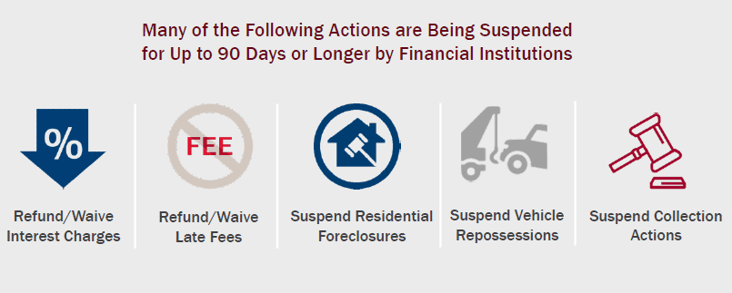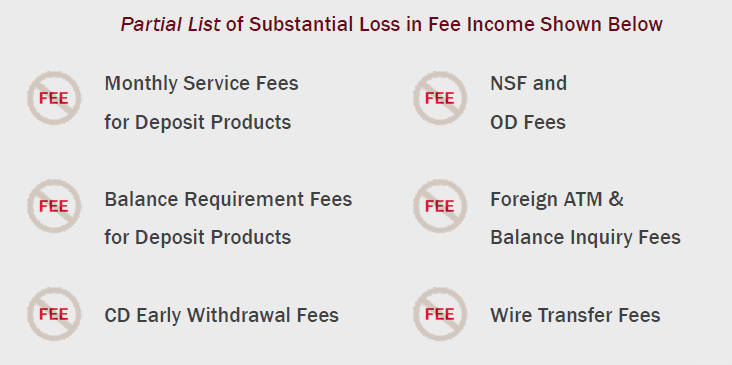As we mentioned in our previous blog, shelter-in-place orders and the virus in general has led to massive unemployment through layoffs, furloughs, and reduced hours for hourly employment. Due to high unemployment, government agencies have stepped in to help through several bills that have been signed into law.
The most prominent of these bills so far has been the CARES Act. The CARES Act was signed into law on March 27, 2020, and includes direct payments to individuals and families, provides extended unemployment insurance, and a significant list of other initiatives designed to help businesses and individuals that have been financially impacted by the Coronavirus. Prior to the CARES Act, multiple government agencies issued a joint memo to financial institutions on ways to help their customers and members.
How Financial Institutions Can Help Customers
On March 9, the FDIC and NCUA published a joint press release that outlined 10 ways financial institutions can help customers and members during these unprecedented times. Click here to read the full press release. If your financial institution has chosen to follow the recommended guidelines, you may have experienced a negative impact in profitability and capital, which is at the center of the huge dilemma banks and credit unions are facing today.
We recommend reading the joint memo and see what steps your financial institution has already undertaken related to this memo, then sit down with the rest of your management group to determine if any of these other initiatives should be implemented to provide relief to your customers in the short-term (for a period of 60-90 days). However, before you do that, we recommend that you pull some data to determine the financial impact of implementing the recommendations.
Loan Assistance for Small Businesses
Another portion of the CARES Act discusses a law regarding the Small Business Administration (SBA) on ways that loan programs could be expanded to help customers and members. In addition to the SBA and the CARES Act, there are other programs within the lending function that can be lifelines to your borrowers. One of these is a skip pay or a deferral program.
Skip pay programs have been around for many years, and if your financial institution is offering one today or has offered one in the past, now may be a great time to revisit the parameters regarding that program. These programs can actually be applied to all of your loan types including mortgage lending, first and second mortgages, your credit card portfolio, commercial lending, and consumer loans including auto loans, recreational vehicles, lines of credit, CDs, secured loans, and all other loan types. If you have not been offering a program up to this point, this might be a great opportunity for you to sit down with your lending group and determine if now is the right time to launch a skip pay program as a great way to help your borrowers today.
Ways You Can Help Your Customers and Members
In addition to these programs, there are other fantastic ways you can provide lifelines to your borrowers. Ceto has researched what other financial institutions across the country have been doing, and you can see a partial list of those initiatives below. We have seen financial institutions refund interest charges, reduce interest charges, or even waive interest for a period of time. In addition, we have also seen financial institutions take the same approach with fees, either waving late fees, refunding those fees, or lowering fees in the short-term. Some have also suspended foreclosures, repossessions and other collection items.

Moving from the lending function to the deposit function, there is also a list of fees or items that can be reviewed and potentially waived for a period of 60-90 days below. Some of these are mentioned within the 10 points of the joint memo. This is a partial list of those items, and it’s important to be aware that there could be a significant impact to non-interest income and profitability in the short term if you were to modify your fee structure.

While these recommendations are great ways to help your customers and members today, we must be aware that this draw on non-interest income will decrease profitability. In addition to this reduction of non-interest income, low-interest rates are going to further lead to margin compression, which is an even larger hit to profitability than the reduction in non-interest income.
If you would like to learn more about how to balance long-term profitability and capital while still helping your customers and members during this unprecedented time, please check out our latest on-demand webinar, “How to Deal with the Coronavirus Pandemic: A Huge Dilemma for Financial Institutions.” This webinar discusses the following topics:
- Similarities and differences from the 2008 banking crisis, and what we’ve learned from it
- The areas that financial institutions will be squeezed, and proactive measures that need to be taken now
- What we might expect from regulators down the road based on what we learned from the 2008 banking crisis
- Steps you need to be taking now to rebuild liquidity and pull out of this dilemma in the future